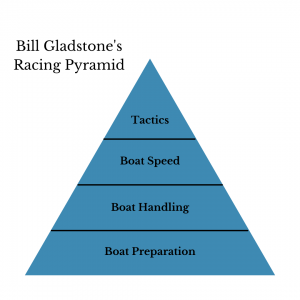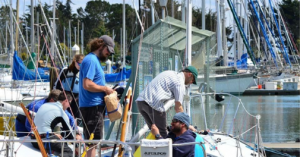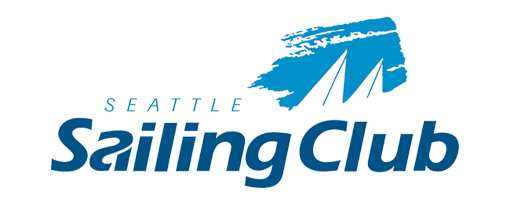The Racing Pyramid – Add Structure to Elevate your Racing
By SSC Race Coach and Instructor, Nojan Moshiri
You can elevate your race program with just a little structure. North Sails author and racing instructor Bill Gladstone’s racing pyramid shows us a great starting point.
 As you climb the pyramid you need to ensure that the lower layers are strong. Tactics are virtually useless if you don’t have the boat speed, and you can’t have boat speed without good boat handling. Finally, you can’t have good handling without boat preparation.
As you climb the pyramid you need to ensure that the lower layers are strong. Tactics are virtually useless if you don’t have the boat speed, and you can’t have boat speed without good boat handling. Finally, you can’t have good handling without boat preparation.
While boat preparation is the base and it’s critical, it’s often true in amateur racing that an experienced crew can finish well in an un-optimized boat. Conversely, even the best prepared boat will finish poorly with a few bad tacks. With Seattle Sailing Club, much of the boat preparation has been done for you. Focus on equipment functionality and making sure that any mechanical glitches are not hindering your ability to execute maneuvers.
Without doubt, boat handling is the area you can realize the largest and most immediate gains. Your goal as a team is to clearly define each person’s role in the crew and then practice the key maneuvers until you build enough muscle memory, then refine the maneuvers. Write down the positions on paper. Practice boat handling to build your team. Practice, even at the dock, can give you a big leg up on your competitors. Time on the water is everything. If you can find a way to be on the water more than your competitors you will realize large advantages. Eventually, you will be orchestrating things as small as where someone puts their feet, or the rate of pulling of lines and more nitty-gritty details. Each optimization will make your boat that much more efficient and faster.
As you increase your boat handling, boat speed and then tactics will start to give you more gains. However, invert the pyramid, try to make big tactical decisions before your team can make the boat go fast, and you will leave the race course disappointed.

“Boat preparation and boat handling go hand-in-hand. Here the author, his crew, and many competitors prepare their boats for the J/24 Nationals in San Francisco in 2015”
Key takeaways:
Boat preparation: Focus on checking for smooth operation of all mechanical parts of the boat. Are winches smooth, are cam cleats holding and releasing well, are halyards in good shape, is the tiller or wheel easy to use, are the sails in serviceable condition, are the controls of the boat efficient and easy to use. Don’t make changes to the boat on race day, plan your changes carefully and for a day you are NOT racing.
Boat handling: Practice positions and maneuvers before race day, even if it’s at the dock. Get out to the race course a little early and practice maneuvers. Write down crew positions and make sure everyone knows their role. Use critical thinking to optimize positions as you learn more about each other’s strengths and weaknesses. Do you think you have your tacks down perfectly? That’s a great time to get some coaching and see how you can make them even better.
Make notes about what is working and what is not and discuss it as a team, after racing. Don’t make changes to crew positions or responsibilities on race day. Keep a light, positive tone during races regardless of how things are going.
